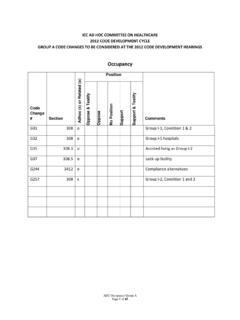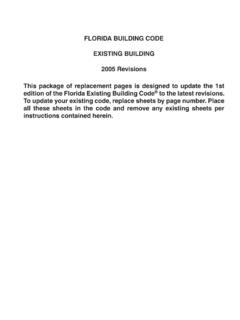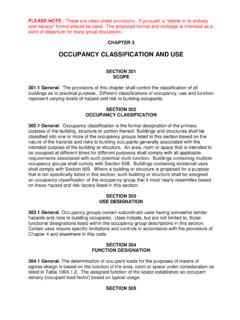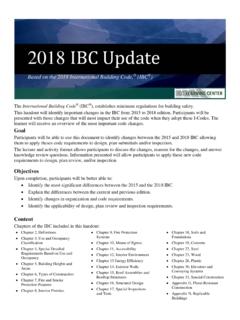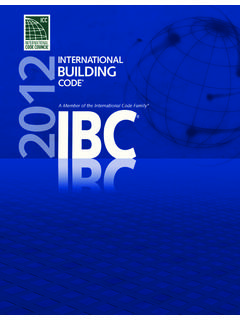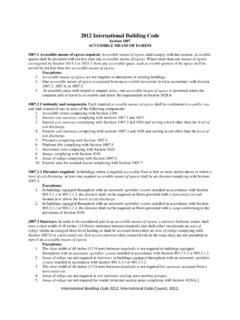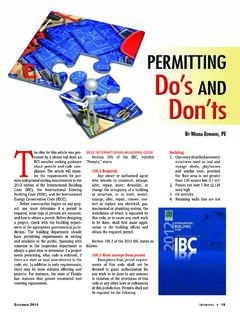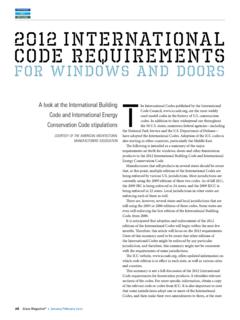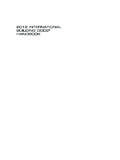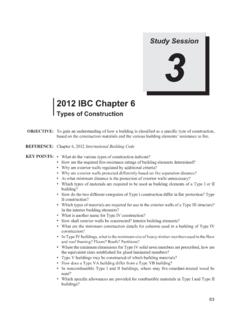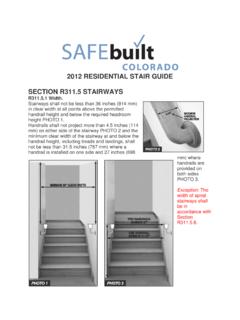Transcription of CHAPTER 34
1 2012 international building code 569 CHAPTER 34 EXISTING STRUCTURESSECTION Scope. The provisions of this CHAPTER shall control thealteration, repair, addition and change of occupancy of exist-ing buildings and : Existing bleachers, grandstands and foldingand telescopic seating shall comply with ICC Maintenance. Buildings and structures, and partsthereof, shall be maintained in a safe and sanitary or safeguards which are required by this code shallbe maintained in conformance with the code edition underwhich installed. The owner or the owner s designated agentshall be responsible for the maintenance of buildings andstructures.
2 To determine compliance with this subsection, thebuilding official shall have the authority to require a buildingor structure to be reinspected. The requirements of this chap-ter shall not provide the basis for removal or abrogation offire protection and safety systems and devices in Compliance. Alterations, repairs, additions andchanges of occupancy to, or relocation of, existing buildingsand structures shall comply with the provisions for altera-tions, repairs, additions and changes of occupancy or reloca-tion, respectively, in the international Energy ConservationCode, international Fire code , international Fuel Gas code , international Mechanical code , international PlumbingCode, international Property Maintenance code , Interna-tional Private Sewage Disposal code , international Residen-tial code and NFPA 70.
3 Where provisions of the other codesconflict with provisions of this CHAPTER , the provisions of thischapter shall take precedence. building materials and systems. building materialsand systems shall comply with the requirements of this Existing materials. Materials already in use in abuilding in compliance with requirements or approvals ineffect at the time of their erection or installation shall bepermitted to remain in use unless determined by the build-ing official to be unsafe per Section New and replacement materials. Except as oth-erwise required or permitted by this code , materials per-mitted by the applicable code for new construction shall beused.
4 Like materials shall be permitted for repairs andalterations, provided no hazard to life, health or property iscreated. Hazardous materials shall not be used where thecode for new construction would not permit their use inbuildings of similar occupancy, purpose and Existing seismic force-resisting the existing seismic force-resisting system is a typethat can be designated ordinary, values of R, 0, and Cd forthe existing seismic force-resisting system shall be thosespecified by this code for an ordinary system unless it isdemonstrated that the existing system will provide perfor-mance equivalent to that of a detailed.
5 Intermediate or spe-cial Alternative compliance. Work performed in accor-dance with the international Existing building code shall bedeemed to comply with the provisions of this Dangerous conditions. The building official shallhave the authority to require the elimination of conditionsdeemed Definitions. The following terms are defined in Chap-ter 2 STRUCTURAL General. Additions to any building or structure shallcomply with the requirements of this code for new construc-tion. Alterations to the existing building or structure shall bemade to ensure that the existing building or structure togetherwith the addition are no less conforming with the provisionsof this code than the existing building or structure was priorto the addition.
6 An existing building together with its addi-tions shall comply with the height and area provisions ofChapter Flood hazard areas. For buildings and structures inflood hazard areas established in Section , any addi-tion that constitutes substantial improvement of the existingstructure, as defined in Section , shall comply with theflood design requirements for new construction, and allaspects of the existing structure shall be brought into compli-ance with the requirements for new construction for buildings and structures in flood hazard areas estab-lished in Section , any additions that do not constitutesubstantial improvement of the existing structure.
7 As definedin Section , are not required to comply with the flooddesign requirements for new construction. EXISTING STRUCTURES5702012 international building code Existing structural elements carrying gravity existing gravity load-carrying structural element forwhich an addition and its related alterations cause an increasein design gravity load of more than 5 percent shall bestrengthened, supplemented, replaced or otherwise altered asneeded to carry the increased gravity load required by thiscode for new structures. Any existing gravity load-carryingstructural element whose gravity load-carrying capacity isdecreased shall be considered an altered element subject tothe requirements of Section Any existing elementthat will form part of the lateral load path for any part of theaddition shall be considered an existing lateral load-carryingstructural element subject to the requirements of Design live load.
8 Where the addition does notresult in increased design live load, existing gravity load-carrying structural elements shall be permitted to be evalu-ated and designed for live loads approved prior to theaddition. If the approved live load is less than thatrequired by Section 1607, the area designed for the non-conforming live load shall be posted with placards ofapproved design indicating the approved live load. Wherethe addition does result in increased design live load, thelive load required by Section 1607 shall be Existing structural elements carrying lateral the addition is structurally independent of the existingstructure, existing lateral load-carrying structural elementsshall be permitted to remain unaltered.
9 Where the addition isnot structurally independent of the existing structure, theexisting structure and its addition acting together as a singlestructure shall be shown to meet the requirements of Sections1609 and : Any existing lateral load-carrying structuralelement whose demand-capacity ratio with the additionconsidered is no more than 10 percent greater than itsdemand-capacity ratio with the addition ignored shall bepermitted to remain unaltered. For purposes of calculatingdemand-capacity ratios, the demand shall consider appli-cable load combinations with design lateral loads or forcesin accordance with Sections 1609 and 1613.
10 For purposesof this exception, comparisons of demand-capacity ratiosand calculation of design lateral loads, forces and capaci-ties shall account for the cumulative effects of additionsand alterations since original Smoke alarms in existing portions of a building . Where an addition is made to a building or structure of aGroup R or I-1 occupancy, the existing building shall be pro-vided with smoke alarms in accordance with Section the international Fire General. Except as provided by Section orthis section, alterations to any building or structure shallcomply with the requirements of the code for new construc-tion.
